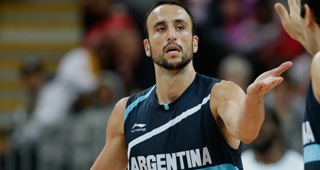In the 2002 World Championships, an up-and-coming Argentina team that featured three future NBA players under the age of 26 (Manu Ginobili, Luis Scola and Andres Nocioni) stunned a complacent Team USA. It was the first defeat of the Americans in a major international tournament since NBA players began participating in 1992.
Team USA’s top scorers (Paul Pierce, Michael Finley, Jermaine O’Neal, Elton Brand) were more comfortable in a slow paced, isolation-heavy offense. In contrast, the way Argentina moved in unison and shared the basketball was a revelation. Everyone, even their big men, could pass and shoot, so the ball never stuck in anyone’s hands.
They all seemed to be between 6’6 and 6’10, which gave them versatility on both sides of the ball. While the USA produces an excess of NBA-caliber guards every year, Argentina’s elite athletes almost always play soccer, unless they have a compelling reason (i.e. excess height) to try something different.
They had two players (Juan “Pepe” Sanchez, Ruben Wolkyowski) who had cups of coffee in the NBA, but Ginobili was the real trailblazer. The MVP of the Euroleague Finals in 2001, Ginobili didn’t have anything left to prove at the international level. He joined the San Antonio Spurs right after the World Championships, quickly establishing himself as a star-caliber player.
At 6’6, 205, Ginobili is a complete shooting guard, with the ability to score, shoot, pass, rebound and defend at a high-level. He’s been a top-3 shooting guard in the NBA for the last decade, but his willingness to come off the bench as well as a series of injury issues have partially obscured his dominance. Ginobili's career per-36 minute average of 19.6 points, 5.1 rebounds and 5.1 assists on 45% shooting and PER of 21.6 are Hall of Fame worthy.
Nor has his impact on the game been limited to Argentina: Ginobili helped popularize the Euro step to an entire generation of guards, foreign and American. He brought the mentality of a soccer player to the basketball court, creating passing angles and driving lanes the NBA had never really seen before. Even at the age of 36, he’s maintained his level of play in London, averaging 19.3 points, 6.3 rebounds and 4.5 assists on 51% shooting.
His countrymen followed him in the NBA: Nocioni and Carlos Delfino (2004), Fabricio Oberto (2005), Walter Hermann (2006) Scola (2007) and Pablo Prigioni (2012). But without another Ginobili, their youth basketball program has steadily slipped over the last decade. Delfino is Argentina’s only key player under the age of 30 and there aren’t many young players coming up the pipeline.
As a result, while Team USA was turning over its entire roster every two years, the same core of Argentine players finished second in 2002, first in 2004, fourth in 2006, third in 2008 and fifth in 2010. Now, in Friday’s Olympic semifinal, the “Golden Generation” has one final chance to defeat the Americans. It will be a much harder task in 2012: Team USA has been built in their image -- except faster, stronger and more athletic.
Instead of viewing competing internationally as a burden, the top American players are now eager to play on the world stage. They’re faster and more skilled than a decade ago, even if they aren’t always as big. And while they were once known for an excess of 1-on-1 play, Team USA has been putting on scintillating displays of free-flowing basketball for the last two weeks.
They start one conventional big man and often play a front-line of LeBron James, Carmelo Anthony and Kevin Durant. Their floor spacing issues, traditionally a nightmare for Team USA, have been more or less resolved with four perimeter players players on the floor at all times. Not only do they have the best athletes in the world, they play a more international style than ever before.
That’s the conundrum facing Argentina, one that became apparent in the second half of their 126-97 loss to the Americans in group play: they want to a fast-paced game where brute power is deemphasized, but that’s exactly what Team USA wants too. Unlike in 2002, the Americans don’t lack for three-point shooting, so packing the paint on defense is a much more dangerous gamble.
In the end, it’s one Argentina will have to make. With very little depth upfront and no shot-blocking, they have no way of slowing down Team USA outside of playing a de-facto zone and hoping they go cold from the perimeter. In their best-case scenario, the Americans misfire from deep, they use Lithuania’s game plan to keep it close than hope Ginobili can steal the game in the final minutes.
An upset on Friday would give them more success in Olympic basketball than the USA in the last eight years. To grasp what an accomplishment that would be, it’s helpful to imagine the situation in reverse: the USA not just consistently outperforming Brazil in a generation’s worth of World Cups, but doing so while playing a more aesthetically pleasing style of soccer that the Brazilians wanted to emulate.

Jonathan Tjarks wrote on the NBA for RealGM from 2011-2016 before joining The Ringer.
Follow @JonathanTjarks on Twitter.


